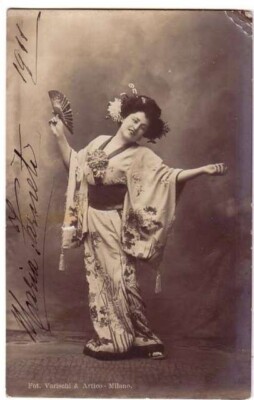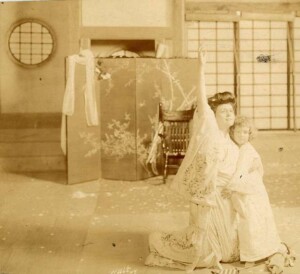In our previous Butterfly Process session with Dr. Kunio Hara, we gained insightful historical context about the genesis of Madama Butterfly, as well as tracing its performance history through the evolving social and geopolitical conditions to the present day. This second session unpacked Orientalism and Cultural Appropriation which are two very significant topics that play a heavy hand in understanding the dynamics at play with why Madama Butterfly can often be problematic.
To tackle the conversation from multiple perspectives, BLO invited a panel of academics, artists, and presenters to show historical and scholarly context alongside real feedback from creatives in the field.
Mari Yoshihara, Professor and Chair of American Studies at the University of Hawai’i, began the conversation by defining what Orientalism is, an assumption that there is a difference between the East and the West, and the value judgements that historically that come with these pre-conceived notions. The exoticization and feminization of the Orient, the conflation of Asian people with objects, and how Europeans have constructed the Orient as a homogenous undifferentiated cultural mass are identified as byproducts of Orientalism.
Professor of English and Asian American Studies at University of Minnesota, Josephine Lee, emphasized and agreed with Mari that Madama Butterfly sits at the intersection of these Oriental characteristics. While the root of current discourse of Orientalism originates from Edward W. Said’s groundbreaking book, Orientalism, it mostly focusses on Arab and Middle Eastern cultures. It’s worth noting that the terms “Orient” and “Oriental” have shifted meanings through time and encompassed various cultural groups east of Venice, Italy.

Maria Farneti in Madama Butterfly. Wikimedia Commons
At this point, I tried to define Cultural Appropriation within the context of our conversation. It’s the process of artists taking aspects of another culture and profiting from it. This process often disregards the original context of symbols, objects, or rituals being borrowed, usually from a more dominant culture taking symbols from a less dominant culture. As cultures evolve however, expectations and understanding around these symbols must also change. Thus, navigating issues of cultural appropriation is pertinent as performing arts organizations begin to shift from a Eurocentric to a multiracial way of producing art. Unfortunately, this Eurocentric tradition is still a contemporary way of thinking for a lot of organizations, when mostly (and frequently) programming and producing the “classics.” It feels like we are forced to choose between keeping the beautiful art, albeit with outdated racial depictions—or getting rid of the work entirely.How do we avoid this tendency toward cancel culture, and shift cultural appropriation towards inclusive, equitable cultural appreciation? A quote by fashion designer Kerby Jean-Raymond helps me think about change as, “Homage without inclusion is appropriation.” Creatives must navigate conversations about representation and evaluate who gets to shape these decisions, evolving the depiction of misinformed fantasies of different cultures to be more nuanced and well-informed storytelling with greater integrity.
We must give support to Asian artists who are questioning and unpacking Oriental stereotypes in their creative work. To that end, I don’t think I was alone in wanting to hear from composer, Huang Ruo, about his experience addressing Madama Butterfly head-on through his latest opera, M. Butterfly, based on David Henry Hwang’s play, set to be premiered in Summer 2022 at Santa Fe Opera.
Instead of immediately reflecting on his own experiences, he asked the group of panelists, “How do we turn the table around [on the original dynamic]?” Ruo further emphasized that one can certainly think of Madama Butterfly as a historical document—as a reflection of the relationship between Asia and the United States during Puccini’s time. In M. Butterfly, not only do Ruo and Hwang challenge the assumptions of East and West (the foundations of Orientalism) but also issues of gender representation. In questioning the male characters as well as the power dynamic between the male and female characters in Madama Butterfly, M. Butterfly offers a new take, and a different perspective, on the familiar narrative.

A scene from “Madame Butterfly,” which opened Feb. 28, 1907, at the Grand Opera House, Seattle. Includes Florence Easton. J. Willis Sayre Collection of Theatrical Photographs, https://www.lib.washington.edu/
One of my favorite illustrations of how an artist of Asian descent can use their art to deflate the tropes of Orientalism David Henry Hwang did with M. Butterfly. In the play, the Chinese opera singer Song Liling poses this to René Gallimard, a French civil servant:
“Consider it this way: what would you say if a blond homecoming queen fell in love with a short Japanese businessman? He treats her cruelly, then goes home for three years, during which time she prays to his picture and turns down marriage from a young Kennedy. Then, when she learns he has remarried, she kills herself. Now I believe you should consider this girl to be a deranged idiot, correct? But because it’s an Oriental who kills herself for a Westerner–ah!–you find it beautiful.”
Returning to the panel, Josephine then posed another question to us, “Why do we keep doing and reproducing Madama Butterfly—what’s the appeal of the story?” She invoked, “If we juxtapose the hyper-visibility of stereotypes with the relative invisibility of actual Asian Americans – this is where the problem lies.” She also noted that for a long time, Asian artists in many performing arts disciplines had to take on exotic or caricature roles to be seen and noticed.
It was clear that we couldn’t talk about the exotic Oriental portrayals on-stage without examining the experiences of Asian creatives offstage. Luckily, Mari shared some information from her book, Musicians from a Different Shore: Asians and Asian Americans in Classical Music. She said there are certain sentiments about Asian performers in classical music; Asian musicians are viewed to be technically perfect but lack individual artistry. Another belief is that they need to perform certain sounds and work within a specific aural landscape that has been ascribed as “Asian.” These are expectations placed on Asian artists because of the perception of Orientalism, and therefore go hand in hand with a conflation of Orientalism with an authentic expression of Asian culture.
Ruo echoed this in his own experience. As a symphonic Asian American composer, generic titles like “Symphony No. 1” get little traction, compared to works with titles that contain words that are often associated with Asian culture like bamboo, silk, incense, porcelain, etc. And these works are often relegated to the token Lunar New Year concerts or outreach performances to the Asian community. In his case, Ruo expressed an ironic sense that he, in fact, welcomes some of this “pigeonholing.” He was happy to step up and create works with Asian themes, if only as an antidote to Orientalism—to create more, and more authentic representations of Asian music and stories. If we, as an audience, are no longer satisfied by ersatz Chinese fairy tales, why not replace them with stories by actual Chinese artists?
Michael emphasized that, “If someone else is telling your story, then it’s not your story.” As a presenter, he has an obligation to curate works while understanding what the lens and its positions are: Where is the subject position of the artist? Where is the subject position of the audience and where are they in the lens? How do you present it and how do you frame it for a ticket buying audience? What kind of dialogue prompts the audience to think of their larger issues? He summarized what is at stake–that Asian people don’t really need Western opera, but if opera is to survive as a multiracial art form, it will need people of Asian descent as contributors on both sides of the footlights.
Following the panel, the singers and panelists gathered in a private room to debrief. There was great eagerness on everyone’s part to continue the conversation, which made me realize we should do a better job at connecting artists with academics in the field. Both groups would seemingly benefit from more dialogue and cross pollination, each providing the other with complimentary context in which to look at these operas and their own work. Next, we are discussing the impact on artists and audiences as we continue to explore the challenges and opportunities for learning with Madama Butterfly.

